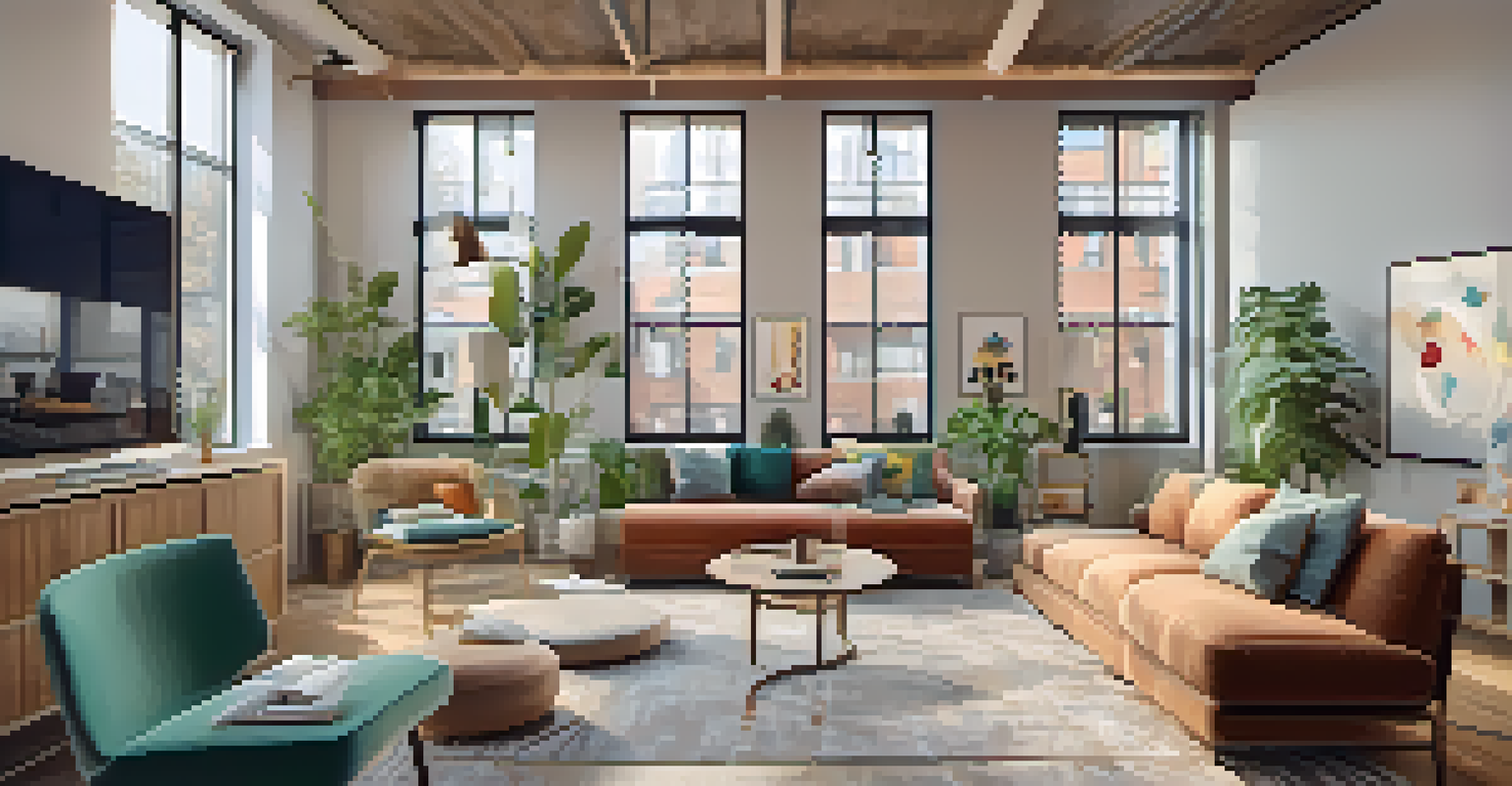The Growth of Flexible Co-Living Spaces in Urban Areas

Understanding Co-Living: A New Urban Lifestyle
Co-living is a modern housing concept that combines private living spaces with shared communal areas. It appeals to a diverse range of residents, from young professionals to digital nomads, who seek affordability and community. This trend has gained traction in urban areas, where the cost of living can be prohibitively high, making shared living an attractive option.
Coming together is a beginning; keeping together is progress; working together is success.
Imagine living in a house where you have your own bedroom but share a kitchen, lounge, and even a rooftop garden with others. This communal setup fosters social interactions and builds a sense of belonging, which is often missing in traditional housing arrangements. For many, it's not just about saving on rent; it's about finding a community in the hustle and bustle of city life.
As cities become more crowded, the need for flexible living arrangements grows. Co-living spaces respond to this demand by offering flexible lease terms and fully furnished units, allowing residents to move in and out with ease. This adaptability is particularly appealing to those who may not want to commit to long-term leases in an ever-changing urban landscape.
The Appeal of Flexible Living Arrangements
One of the biggest draws of co-living spaces is their flexibility. Many co-living providers offer month-to-month leases, accommodating the transient nature of urban life. This is especially beneficial for students, young professionals, and remote workers who may move cities frequently or require short-term housing.

Additionally, the hassle of setting up utilities and furnishing a space is eliminated, as most co-living arrangements come fully equipped. Residents can simply move in with their personal belongings and start their new life without the typical stress that comes with relocating. This ease of transition makes co-living an attractive choice for many.
Co-Living Combines Privacy and Community
Co-living offers private living spaces alongside shared communal areas, fostering a sense of belonging in urban environments.
Furthermore, the opportunity to live with like-minded individuals creates an environment that promotes networking and collaboration. Residents often find themselves in a melting pot of ideas, cultures, and professions, making it a unique living experience that transcends traditional housing.
The Role of Community in Co-Living Spaces
Community is at the heart of the co-living experience. Many co-living spaces go a step further by organizing events, workshops, and communal meals, encouraging residents to engage and connect. This focus on community helps alleviate feelings of isolation that can arise in large cities.
The greatness of a community is most accurately measured by the compassionate actions of its members.
For example, some co-living spaces host weekly game nights or yoga classes, where residents can unwind and bond over shared interests. These activities not only make living together more enjoyable but also foster friendships that can extend beyond the walls of their shared home.
Moreover, having a support system of neighbors can be invaluable, especially for newcomers to a city. Residents often find themselves sharing tips about local attractions, job opportunities, or even personal recommendations, creating a tight-knit environment that feels like home.
Economic Factors Driving Co-Living Growth
The rising cost of living in urban areas is a significant factor contributing to the growth of co-living spaces. As housing prices continue to soar, many individuals and families are looking for more affordable options that don't compromise on quality or community. Co-living presents a solution that fits within tighter budgets while still offering desirable amenities.
Additionally, co-living spaces often provide inclusive pricing, covering utilities, internet, and maintenance within the monthly rent. This transparency in pricing is appealing for those who want to avoid unexpected expenses. By consolidating costs, residents can manage their finances more effectively.
Flexibility is Key in Urban Living
With month-to-month leases and fully furnished units, co-living spaces provide a hassle-free transition for residents who frequently relocate.
The economic shifts brought on by the global pandemic have also played a role in the co-living trend. With more people working remotely, the traditional office space is evolving, and many are seeking living arrangements that reflect this new normal. Co-living allows for a blend of work and leisure, making it a viable option for the modern worker.
Design Trends in Co-Living Spaces
The design of co-living spaces plays a crucial role in their appeal. Many developers are focusing on creating aesthetically pleasing environments that promote comfort and functionality. Open-plan living areas, communal kitchens, and cozy lounges are common features designed to enhance social interaction among residents.
Moreover, sustainability and eco-friendliness are becoming integral to co-living designs. Many spaces incorporate green materials, energy-efficient appliances, and communal gardens, reflecting a growing awareness of environmental issues. This not only attracts environmentally conscious residents but also creates a healthier living environment.
Additionally, the incorporation of smart technology in co-living spaces is on the rise. From smart locks to energy management systems, these innovations facilitate a more convenient living experience. Residents appreciate the blend of modern technology with communal living, offering both comfort and connectivity.
Challenges Facing the Co-Living Market
Despite the growth of co-living spaces, there are challenges that the market faces. One of the primary concerns is the potential for conflicts among residents, particularly when it comes to shared spaces and differing lifestyles. Establishing house rules and fostering open communication can help mitigate these issues.
Additionally, as the co-living trend gains popularity, competition among providers increases, leading to a saturation of the market in certain areas. This can make it difficult for new entrants to differentiate themselves or maintain occupancy rates. Unique offerings and quality service become essential for survival.
Community Events Enhance Connections
Co-living spaces often host social activities that encourage residents to bond, alleviating feelings of isolation in busy cities.
Moreover, regulatory hurdles can pose challenges for co-living operators. Local zoning laws and housing regulations may not always accommodate the flexible nature of co-living arrangements. Navigating these legal landscapes is crucial for the successful establishment and sustainability of co-living spaces.
The Future of Co-Living Spaces in Urban Areas
Looking ahead, the future of co-living spaces appears promising as urban areas continue to evolve. With the increasing integration of technology, we can expect even more innovative solutions that enhance the co-living experience. Virtual communities and digital platforms could play a role in connecting residents before they even move in.
As the demand for affordable housing solutions persists, co-living is likely to become a mainstream option for many city dwellers. Developers are expected to pay closer attention to the needs and preferences of residents, creating tailored experiences that further enhance community living.

Ultimately, as cities grow and change, the adaptability of co-living spaces positions them well to meet the diverse needs of future residents. The blend of community, affordability, and flexibility will likely keep co-living at the forefront of urban housing solutions for years to come.